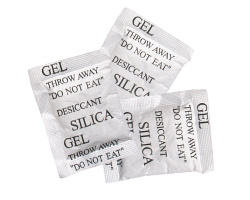How can I reuse or recycle silica gel crystal sachets?
 The other week when I asked how people make their home baked goods last longer, Dani suggested using little packets of silica gel crystals to a biscuit jar to draw the moisture away from the munchables. (I’ve heard rice can be used in the same way.)
The other week when I asked how people make their home baked goods last longer, Dani suggested using little packets of silica gel crystals to a biscuit jar to draw the moisture away from the munchables. (I’ve heard rice can be used in the same way.)
Dani’s comment got me thinking about other ways that those little sachets of silica gel could be reused. Dani gets hers from bottles of vitamins but they are often included with other things too – I’ve had them in shoes or leather bags/purses, or thrown in with deliveries of dried food items.
Care should be taken when reusing these pouches – because silica gel crystals can cause irritation to the repository and digestive tracts – but their moisture absorbing qualities are very useful: they can absorb up to 40% of its own weight in water vapour.
Looking around the web, people suggest using them to protect sensitive items from getting damp: important papers, seeds, camera/electronic equipment – even jewellery (the moisture adds to tarnish on silver). You can also use silica gel crystals to as cat litter – but I imagine you’d need a helluva lot of these little sachets to fill a tray.
What else can you do with them?























Another use for the silica gel sachets:
My son’s new cell phone got moisture inside – we opened it up, took out the battery and sim card and placed the phone and the battery in a sealed container with the sachets, overnight. The next day it was comlpetely dry and working!
Saved having to recycle a cell phone :-)
Although silica gel crystal sachets are used to absorb moisture, when they reach their water-absorbing capacity they no longer work. They must be regenerated by driving off the absorbed water in an oven or a microwave. In an oven this can be done at around 50 or 60 Celsius. Not too hot or the sachet fabric will char. If the silica crystals are coloured they will be blue when regenerated and pink when they have absorbed all the moisture they are capable of absorbing. If they are not coloured they will need some time in the oven to be sure they have `dried out`. How long depends, obviously, on the size of the sachet. After regeneration they should be stored in an air-tight container. Left about they will simply absorb moisture from the room.
Hi Mark,
I thought I’d read something about that being possible but couldn’t find the details the other day to mention it in the post – thanks for confirming I’m not going mad!
:)
laboratories use silica crystals like this to remove water from other chemicals. if you have a lot try a school/university or hospital lab
use it to dry flowers with…craft stores and craft sections of stores sell packs of the silica to dessicate flowers with…
I usually take some capsules with me to work in a pill box and noticed that the contents eventually became solid. I began saving the silica pouches from vitamins/medicines and using them in the pill box and now that never happens.
My friends ude those little paggs to protect their geocaching tubes/containers… Or at least what’s inside :D
I grow my own veggies and keep my seed packets in a tin in the house, so I keep a couple in my seed tin to preserve the seeds from moisture.
Bought a couple of 50g packets. Throw them in the toolbox, chest/drawers, anything with a confined space really to prevent rust, moisture, damp problems.
1.Put packs in your ammo cans and gun cases/safes to keep dry.
2.Protect personal papers and important documents by putting some gel in a baggie wherever these are stored.
3.Keep with photos to spare them from humidity. Tuck a small envelope in the back of frames to protect even the ones hanging on your walls.
4.Store in camera bags and with film. After snapping photos in cold or wet conditions, silica gel will absorb moisture to keep your lens from fogging or streaking.
5.Leave a couple packs in your tool box to prevent rusting.
6.Use the material to dry flowers.